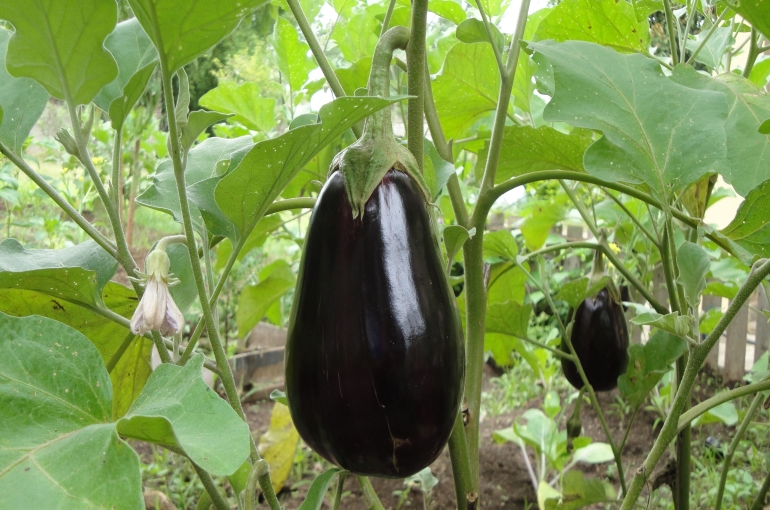8 things to consider when growing Eggplants in your Backyard

This post is also available in:
This post is also available in:
![]() Español (Spanish)
Español (Spanish) ![]() Français (French)
Français (French) ![]() Deutsch (German)
Deutsch (German) ![]() Nederlands (Dutch)
Nederlands (Dutch) ![]() हिन्दी (Hindi)
हिन्दी (Hindi) ![]() العربية (Arabic)
العربية (Arabic) ![]() Türkçe (Turkish)
Türkçe (Turkish) ![]() 简体中文 (Chinese (Simplified))
简体中文 (Chinese (Simplified)) ![]() Русский (Russian)
Русский (Russian) ![]() Italiano (Italian)
Italiano (Italian) ![]() Português (Portuguese (Brazil))
Português (Portuguese (Brazil)) ![]() Indonesia (Indonesian)
Indonesia (Indonesian)
More and more people like to grow their own fruits and vegetables for hobby, self-satisfaction and to control what they eat. However, growing fruits and vegetables in your backyard has some risks, do’s and dont’s and there are some things you certainly need to avoid.
Things to consider when growing Eggplant:
- Eggplant temperature requirements are high. They need temperatures from 20°C to 30°C (70°F – 85°F) and plenty of sunlight in order to thrive. Frost or temperature above 35°C (95°F) may cause a delay in flowering and serious damage to tissues and flowers. In most eggplant-producing countries, the best period to start eggplant cultivation is during the second half of spring. However, in the United States (Florida) and in the United Arab Emirates, planting normally takes place during August and harvesting starts from November onwards.
- If you consider starting growing eggplants from seeds, be sure to buy certified seeds from a legitimate seller. Otherwise, the germination rates will probably be low and you will lose your time. Keep in mind that eggplant seeds have low tolerance in cold. Thus, you may consider to sow them primarily in seedbeds keeping the soil temperature at optimum levels 21-25 °C (70-77°F). You can also use turf as a substrate for optimum aeration. If you are planning to grow more than one plant, make sure to leave at least 40 cm (16 inches) space around each plant. Make sure to keep the seeds moist until germination. The seed will approximately sprout in 8-17 days, depending on the environmental conditions. The right time to transplant them in their final positions is 4-6 weeks after sowing when they will have 3-4 real leaves.
- If you don’t want to mess with seeds, you may buy your plants from a legitimate seller and directly transplant them into their final positions. Keep in mind that eggplant transplanting will probably not be successful in temperatures lower than 21°C – 70°F.
- Some producers prefer to prune the peripheral stems of the plant, forcing it to develop further through the two main stems. Pruning also facilitates proper aeration and thus, protects the plant from humidity favored infections. Others claim that pruning delays the plant growth and fruit set. Moreover, many producers help the plant by removing most of the shrunk flowers, leaving the stronger ones. This method helps the plant distribute more nutrients to the remaining flowers, which will eventually produce fewer, but bigger fruits.
- Most people who growing eggplants prefer to stack their plants using wooden stakes 1-1.5m (50-60 inches) long. This technique prevents foliage and fruits from touching the ground and thus, protects the plant from soil pests and diseases. Moreover, stacking makes it easier to harvest the fruits and improves the aeration and general health of the plant.
- Eggplants generally have middle to high tolerance in drought. On the other hand, they do not like soggy soil. Thus, you may avoid excessive irrigation. On average, eggplants need 1 liter of water per plant every 3 days. This, of course, is not a rule. Sandy soils may need more water as they normally cannot preserve enough water close to roots. On the other hand, heavy clay soils, where there is probably no proper drainage, may need less irrigation.
- When it comes to backyard cultivation, many growers prefer to apply manure or compost as fertilization methods during the growing period, to increase mainly nitrogen and potassium in the soil.
- Eggplants mature and can be harvested 60 to 80 days from transplanting. It is best to harvest the fruits before their seeds turn brown. If all things go well, you may be able to harvest up to 6-8 well-shaped eggplants from every healthy and thriving plant. Commercial growers after years of practice collect 12-15 eggplants for every healthy plant, but this also depends on the variety.








































































